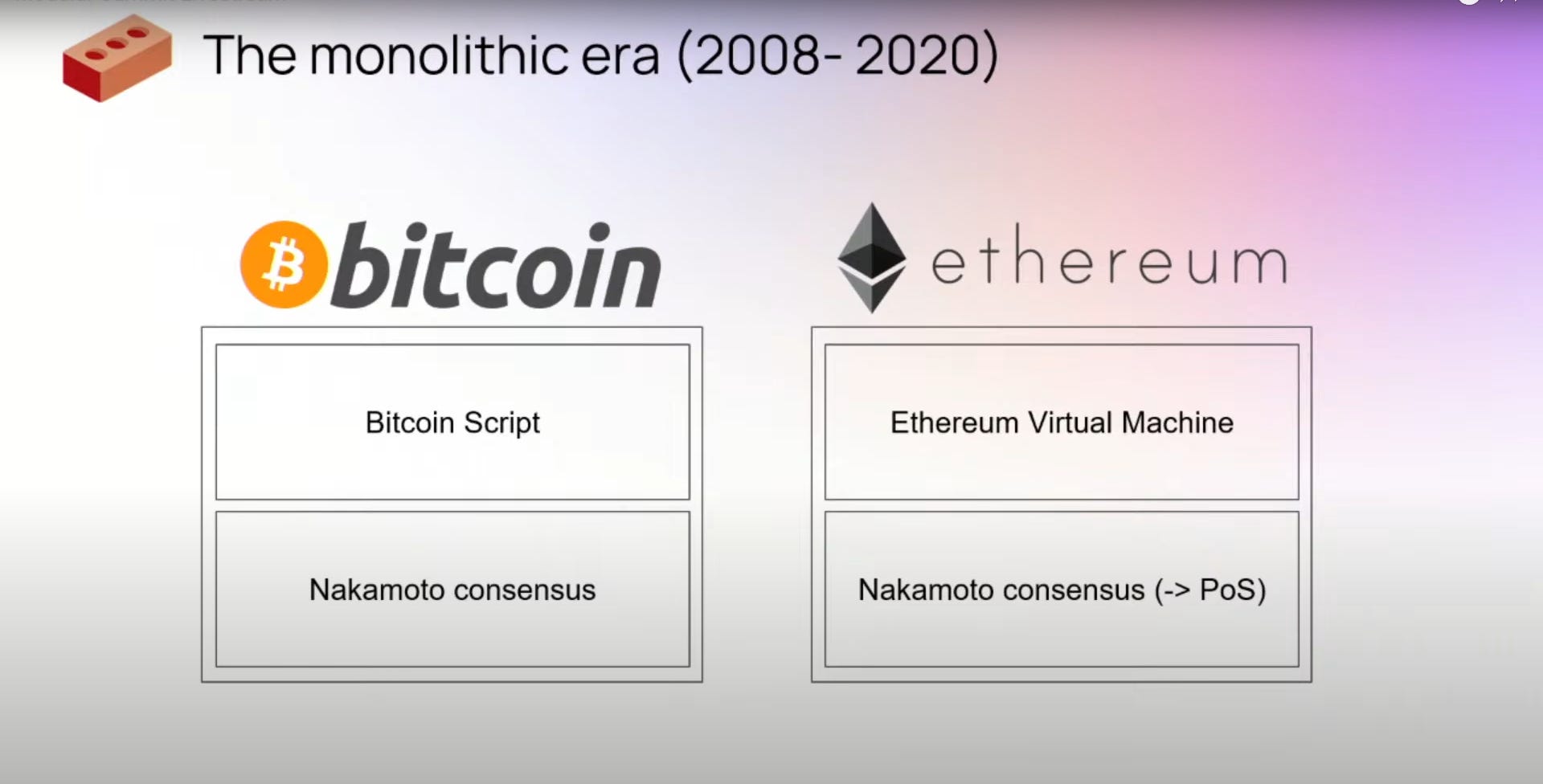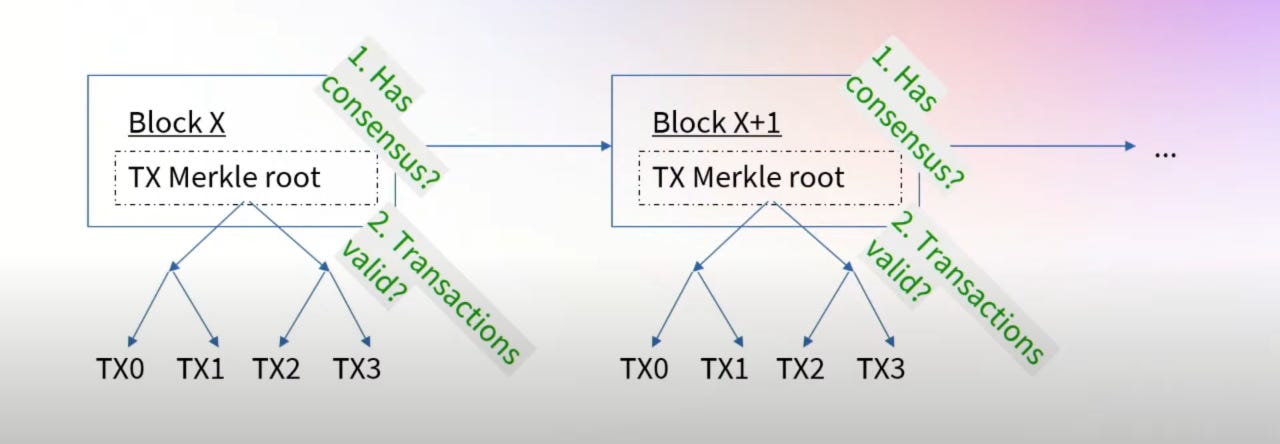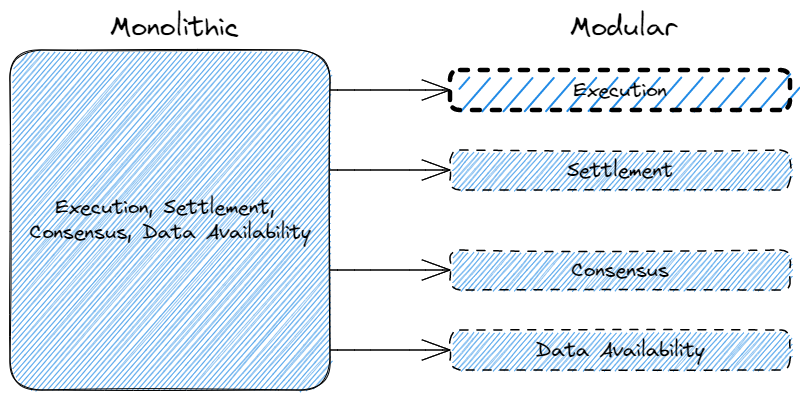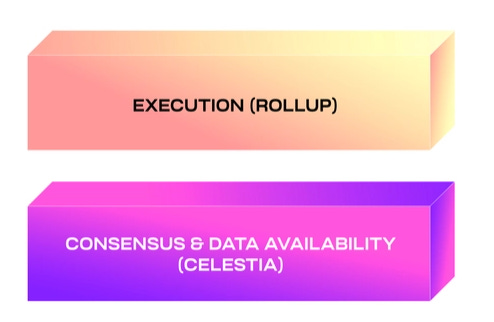Deep Diving: Modular Stack Part-1
 Roq4
Roq4
Monolithic First!
To understand modular structures, we must first establish the concept of a monolithic chain in our minds and answer the question of why we need modular structures. When Bitcoin was first announced as a monolithic chain in 2008, it was said that validators would carry out both transaction execution and consensus on the network. Despite more than 10 years passing since then, projects that have emerged have continued to follow a similar structure without changing it. Even when the first idea for Ethereum was put forward in 2013, it followed a similar path to Bitcoin, but instead of an execution environment, it came with a smart contract environment called the Ethereum Virtual Machine (EVM). However, when we look at the general structure, we see that it is not very different and that full nodes in a monolithic structure offer similar services.

So What Is the Problem?🧐
The problem is very simple and can be summarized in one word: scalability. To be more specific, validators and full nodes in the chain must answer two questions for each block:
Is there a consensus in this block?
Are all the transactions in this block valid?
As can be seen from these two questions, this situation becomes limiting in monolithic chains as the number of transactions on the network increases, causing scalability problems. This is because full nodes must check all previous states of the network to determine whether transactions are valid or not.

The Blockchain Scalability Trilemma 🚩
We have briefly looked at monolithic chains and learned about their main problem, scalability. Now, we will look at the Blockchain Trilemma, the reason for the concept of a modular structure. If you ask why it is called the Blockchain Trilemma, it is assumed that only two of the three main headings mentioned below can be met in a blockchain model, and therefore there is a dilemma.

Security
The security of a blockchain can be measured by its resistance to attacks on the network, and no blockchain wants to give up on security. A large part of the security of a blockchain is related to validators and miners. In particular, in chains with Proof of Stake (PoS) consensus, validators are responsible for registering transactions on the chain. To become a validator on any blockchain, you must stake a certain amount of tokens on the chain. To prevent malicious validators, a method called slashing is used, in which the malicious validators' shares are burned. Security is generally considered the most indispensable of these three elements.
Decentralization
One of the most important differences between blockchains and traditional systems is that they are open and can be verified by anyone. Users can run a node and confirm whether the system is working properly. Nodes fully validated by the blockchain (full nodes) play an important role in terms of security.
Scalability
As the number of users in a blockchain mechanism increases, the number of transactions made on it also increases proportionally. As a result, as the number of transactions on the blockchain increases, the workload required to validate the chain also increases. If it becomes more difficult to validate the chain than it should be, the number of nodes working on the chain decreases, and decentralization is lost.

As can be seen from the equation, for a blockchain to be scalable, the cost of transactions must decrease as the number of transactions increases.
A Quick Transition to Modular Stack🚀
Many people who work with blockchains have always struggled to create an optimal system. As mentioned at the beginning of the article, many of the structures tried so far have been built on a single chain on a single network and have not found a solution for scalability. As an indirect solution, two different ideas have come to mind so far, sharding and L2 systems. The purpose of these systems is to provide external resources for scaling L1 systems. This external intervention has revealed that a single blockchain structure does not have to do everything on its own.
The structure behind modular chains is the Modular Design model, which can be defined as the division of a main system into small parts (layers). In this model, the layers are independent within themselves and can interact with other systems.
A modular chain carries a few specifically selected functions, rather than carrying all blockchain functions, as in monolithic chains. The main difference in modular structures is that these functions are in different layers (like the example of the small parts of the main system mentioned in the previous paragraph).

Modular Stack Layers👀
We have gradually begun to understand the differences between modular and monolithic chains and why we need modular chains, and we have seen that while monolithic structures are mentioned as a single main layer, modular structures are divided into small main parts within this main layer. Let's also look at what happens in these layers and the tasks of these layers.
Consensus Layer
The Consensus Layer receives arbitrary data or messages in a multiple and disorganized order and organizes these data or messages. Simply put, any developer on the network can send many different messages to the network, and the consensus layer tells the blockchain which messages should be in what order.

Data Availability Layer
After the Consensus Layer decides the order in which data should be arranged, it must inform the network about what the data or messages are about. If this previously agreed data is not reported, users and applications on the network cannot be aware of what the data is, and they cannot even know the status of their transactions. The Data Availability Layer ensures the validation of these organized data.
Execution Layer
The Execution Layer is the layer where all transactions recorded on the blockchain network are executed. For example, Rollups are a specialized type on the Execution Layer of Modular Blockchains.

Last Words ⌛
Like all technologies in the world, blockchain technology is also evolving and looking for new doors and ways for itself. The main reason for this search is to maximize the efficiency of labor as much as possible. Modular chains will be one of the most favored in the near future of blockchain technology. Modular structures offer a new solution proposal as a whole from different autonomous layers instead of staying on a single layer in a single network like monolithic structures to solve the scalability problem.
Sources
Subscribe to my newsletter
Read articles from Roq4 directly inside your inbox. Subscribe to the newsletter, and don't miss out.
Written by
